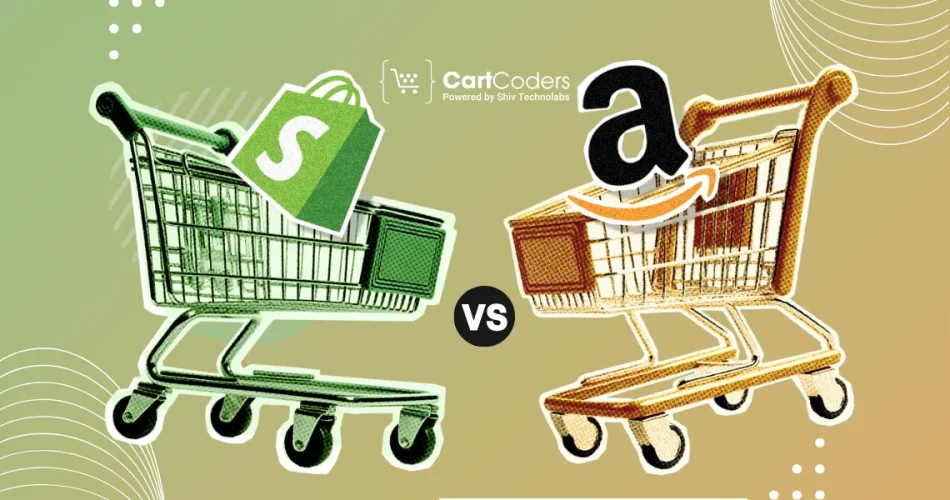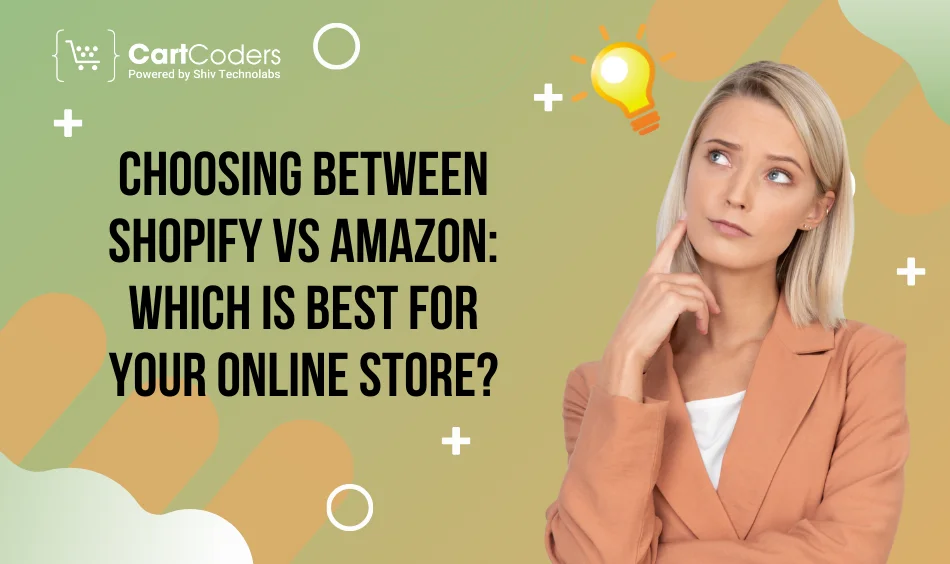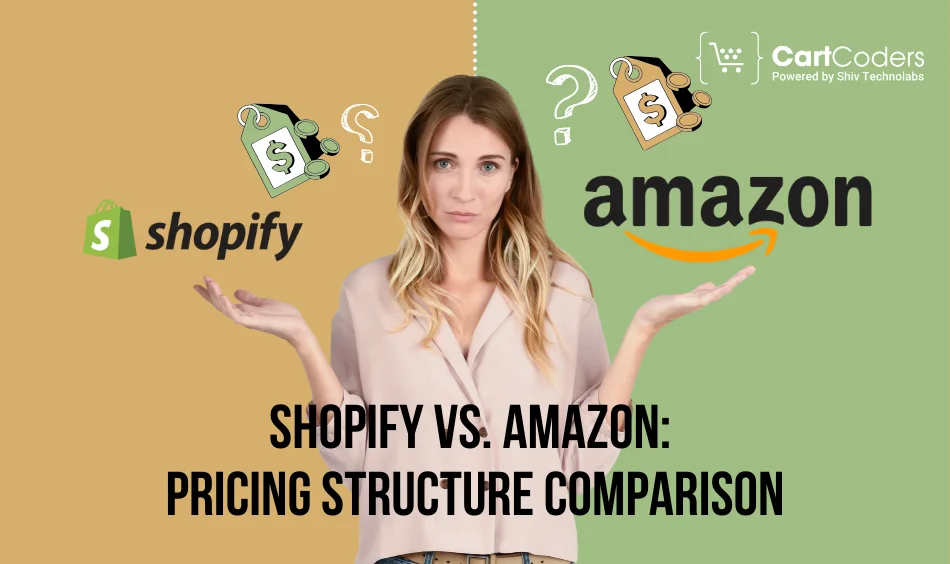Custom Engagement Solutions
Unlock tailored solutions with a free, no-obligation strategy session.
Expert Developers & Engineers on Demand
Scale Your Team with Skilled IT Professionals
Expert Guidance for Digital Transformation

The eCommerce world gives new business owners plenty of choices. Two names stand out—Shopify and Amazon. Picking the right platform is one of the most important steps when starting an online business. Each has its strengths, and each works well for different goals.
This blog will compare these two leading eCommerce platforms and help you decide if selling on Shopify vs Amazon matches your business plan. You’ll find out how both options work, what it costs to get started, and which is the best platform for your online store. If you’re thinking about shopify shopping online or want to reach millions through Amazon, this guide will help you make a smart move.
Shopify is a website builder made for online stores. You create your online store, pick a design, and add products. Shopify shopping online puts you in charge of everything from design to marketing. You get full control of your brand, product listings, and customer experience.
It gives you the tools to add products, manage inventory, accept payments, and customize your website’s look. With Shopify, you don’t need technical skills to launch your store.
Shopify gives you everything you need to build, manage, and grow an online store. Whether you’re selling one product or thousands, Shopify makes running an eCommerce business easier and more efficient.
Amazon, on the other hand, is a marketplace. You list products on a site that millions visit daily. When you sell on Amazon, you join a massive group of sellers, but you have less control over how your store looks. Shoppers visit Amazon for the wide range of options and trusted service.
Amazon makes it simple to reach more customers and grow your business by providing strong tools for selling, shipping, and getting paid—all in one place.
Also Read: How To Sell On Amazon Using Your Shopify Store?
When it comes to eCommerce platform comparisons, Shopify gives you a branded store, while Amazon connects you to a large audience fast. Let’s see what that means for your business.

When it comes to selling products online, both Shopify and Amazon have strong points. The best choice depends on your business goals, brand needs, and how you want to reach customers. Here’s a side-by-side comparison of Shopify vs Amazon to help you decide:
| Feature | Shopify | Amazon |
| Ownership & Branding | Full control over store design and branding | Follows Amazon’s design; limited customization |
| Customer Reach | You drive traffic through marketing and SEO | Access to millions of active Amazon shoppers |
| Store Setup | Create a custom website for your products | List products in Amazon’s marketplace |
| Fees & Costs | Monthly plans, payment fees, and app costs | Per sale fees, monthly subscription for Pro |
| Product Listing | Unlimited products, flexible categories | List by Amazon’s rules, possible restrictions |
| Marketing Tools | SEO, email marketing, and social integrations | Amazon Ads, limited direct marketing |
| Fulfillment Options | Ship orders yourself, use third-party logistics, or the Shopify Fulfillment Network | Fulfillment by Amazon (FBA) or handle shipping yourself |
| Customer Data | Full access to customer emails and info | Limited access, Amazon controls data |
| Dropshipping | Easy to connect with dropshipping suppliers | Strict dropshipping rules |
| Support | 24/7 support from Shopify | Support from Amazon Seller Central |
| Ideal For | Building a unique brand, long-term growth | Fast sales, big audience, less focus on brand |
Shopify stands out for sellers who want control, flexibility, and brand growth. Here’s when you should consider Shopify for selling online products:
Shopify fits best if you’re focused on building your brand, customizing your store, and growing your business for the long term.
Amazon is ideal for sellers who want speed, reach, and simplicity. Consider Amazon for selling online products if:
Amazon is the right fit if your focus is on quick sales, large audiences, and simplified logistics, rather than running a custom store or building a unique brand identity.
Also Read: How to Build a Website Like Amazon: Steps, Features, and Costs

Comparing Shopify vs Amazon pricing reveals important differences in how each platform charges sellers. Understanding these costs helps you choose the best option for your online store’s needs and budget.
| Feature | Shopify | Amazon |
| Subscription Plans | – Starter: $5/month – Basic: $39/month – Shopify: $105/month – Advanced: $399/month – Plus: Custom pricing, starting at $2,500/month | – Individual Plan: $0/month + $0.99 per item sold – Professional Plan: $39.99/month |
| Transaction Fees | – Online Credit Card Rates:- Basic: 2.9% + 30¢ – Shopify: 2.7% + 30¢ – Advanced: 2.5% + 30¢ – Additional fees apply if not using Shopify Payments | – Referral Fees: Vary by category, typically 8% to 15% per item sold |
| Fulfillment Fees | Varies based on shipping methods and third-party logistics providers | Fulfillment by Amazon (FBA): Fees based on size and weight of the product; for example, standard-size items range from $2.29 to $5.85 per unit |
| Storage Fees | Dependent on the third-party storage solutions used | Monthly storage fees: $0.78 per cubic foot for standard-size items (non-peak months) |
| Additional Fees | Costs for premium themes, apps, and POS hardware | Possible fees for high return rates, low inventory levels, and optional advertising services |
When choosing between Shopify vs Amazon, consider your business goals, desired level of control over the customer experience, and how fees will affect your profitability.
Dropshipping has become a popular way to run an online business with low risk and no need for warehouse space. Both Shopify and Amazon let you run a dropshipping store, but the process and rules are not the same.
Shopify is often the first choice for many dropshipping businesses. It supports dropshipping out of the box and connects easily with major dropshipping apps like DSers, Spocket, and Oberlo. You can add products from these suppliers to your store in just a few clicks.
Also Read: How to Add Product on Shopify for Dropshipping: Step-By-Step Guide
Amazon allows dropshipping, but with strict requirements. Sellers must be listed as the seller of record on all packing slips and invoices. Do not ship orders with third-party branding or supplier information. Be responsible for returns and customer service.
Consider your business goals, your need for flexibility, and how much you want to manage branding. This will help you pick the best platform, Shopify vs Amazon, for your dropshipping business.
CartCoders offers expert Shopify development services to help your business grow faster and stand out in a crowded market. Our team works closely with you to design custom themes, develop unique features, and set up smooth integrations with payment gateways, shipping providers, and marketing tools.
Whether you are starting a new store or looking to upgrade your current site, CartCoders delivers solutions tailored to your needs. Our developers stay up-to-date with the latest trends and follow best practices to improve your store’s performance, speed, and user experience.
Choosing between Shopify and Amazon comes down to your business goals and how you want to grow online. Shopify offers flexibility, branding, and room for long-term growth, while Amazon gives you instant access to a huge customer base and simple selling tools. Think about your priorities—control, speed, or audience reach—before you pick the best platform for your online store. No matter which path you take, success starts with the right strategy and a strong commitment to your customers.
If you decide to build your store on Shopify, CartCoders can help you get started or take your site to the next level. With the right support and a clear strategy, you can turn your online business idea into real results. Reach out to us to start building or improving your online store today.
Projects delivered in 15+ industries.
95% retention rate, building lasting partnerships.
Serving clients across 25+ countries.
60+ pros | 10+ years of experience.